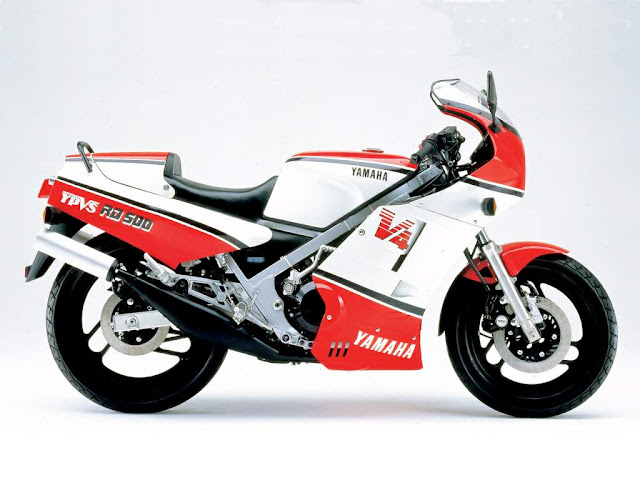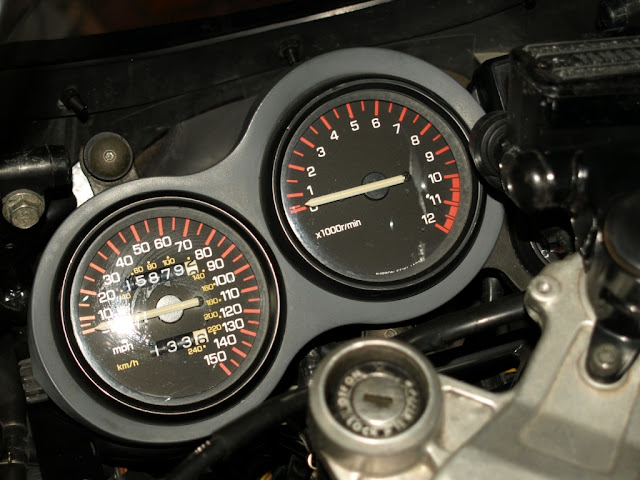Yamaha RD500LC
The Yamaha engine felt flat below 6000rpni, hut once the two-stroke V4 hit its power band in first gear, the lightweight l.C liked nothing better than to scream off with its front wheel in the air. The race- replica four 's need for high revs resulted in a thrilling ride on the road, and made i >beying speed limits almost impossible.
Few superbikes have been as eagerly anticipated as the RD500LC. In 1983 the C-9IH long-standing success of Yamaha’s middleweight two-stroke twins, combined with the factory's success in 5(X)cc grand prix racing, made a 500cc four-cylinder race replica seem the logical next step. Such was the demand that some magazines went as far as publishing spoof road tests of a machine that did not exist.
When Yamaha finally put the real thing into production in the following year, few who rode one were disappointed. The RD500LC looked superb, w ith a racy full fairing in red and white colours similar to those of the factory OW76 that Eddie Lawson was riding to victory in that season’s world championship. Like Lawson’s racer, the 500LC was powered by a liquid-cooled V4 two-stroke engine. The roadster produced 90bhp, weighed an equally impressive 392lb (178kg) dry. and screamed to almost I40mph (225km/h).
Two-stroke heritage
Rather than being developed directly from the racebike engine, the LC’s 499cc, 50-degree V4 powerplant was essentially two RD250LC units with bottom ends geared together, and with a gear- driven balancer shaft to reduce vibration. Induction system, engine porting and exhaust design were very different to the OW76 racer’s, but bore and stroke dimensions of 56.4 x 50mm were almost identical, and the roadster also shared features including exhaust power valves.
Apart from the addition of lights and other roadgoing necessities, the main chassis difference between roadster and racer was that the RD500LC’s frame was made from square-section steel tubing instead of aluminium. This was still one dramatically purposeful streetbike though, with high quality chassis parts including anti-dive equipped telescopic forks, plus a single rear shock unit positioned horizontally beneath the engine.
The Yamaha’s look and specification were mouth-watering, and its performance lived up to expectation. In typical two-stroke fashion the V4 felt flat at low revs, then came into its power band at 6000rpm with a crackle of its exhausts and a blast of acceleration that sent the lightweight machine shooting forward at breathtaking rate. That meant that in top gear it came alive only at about lOOmph (I6lkm/h). Fortunately. Yamaha had supplied a good pair of mirrors...
Even more importantly, the 5()()LC's handling was a match for its motor. As well as light and quick steering, aided by its 16-inch front wheel, it was stable in slower bends and high-speed curves alike. Sometimes the front end got slightly twitch) when the bike hit a bump under acceleration. But that was no real problem, and the Yamaha’s powerful triple-disc brake system was among the best in motorcycling.
Yamaha had succeeded in creating a bike that felt like a racer on the road, and the RD500LC proved its ability on the track with victor), against many big four-strokes, in Australia's prestigious Castrol Six-Hour production race. In the showrooms it was less successful, despite all the pre-launch hysteria. Draw backs included poor fuel consumption, vibration, mediocre finish and a high price. Perhaps the real problem was that the RD500LC was just a little too much like a real racebike for its own good.
Yamaha's V4 Revolution
Before building the RD500LC, Yamaha also led the rro500cc grands prix. Triple champion Kenny Roberts debu 2-dec- 1982, and is seen here leading fellow works rider Graeme Crcsc. .vt>: the previous OW60 square-four. The OW61, which had disc-valve - lacked mid-range power and also handled poorly but the 1984-rroOr 2 featuring reed-valve induction and a Deltabox aluminium frame, wa- ‘ -better. Eddie Lawson's world championship victory that season was re * ' ' in nine years for Yamaha's 500cc V4.
In corners few bikes came close to matching the RD500LC, which combined light weigh: with a rigid steel frame. fire: suspension and plenty of grip and ground clearance
With its full fairing seat hump and two-stroke exhaust system, the RD500LC was the closest thing yet to a GP bike on the road.
Specification Yamaha RD500LC (1984)
- Engine Liquid-cooled two-stroke 50-degree V4
- Capacity 499cc (56.4 x 50mm)
- Maximum power 90bhp @ 8500rpm
- Transmission Six-speed, chain final drive
- Frame Steel twin downtube
- Suspension Telescopic front; single shock rear
- Brakes Twin discs front; disc rear
- Weight 392lb (178kg)
- Top speed 138mph (222km/h)























0 comments: